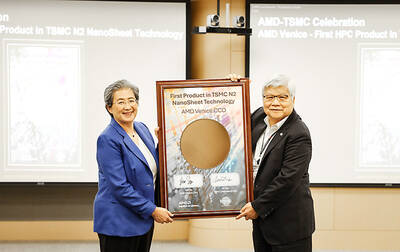China’s home price declines eased for a second month last month, offering a rare glimmer of hope to the embattled property sector.
New home prices in 70 cities, excluding state-subsidized housing, fell 0.04 percent last month from December, when they dropped 0.28 percent, Chinese National Bureau of Statistics figures showed yesterday.
Prices in large cities rose.
Sentiment in China’s home market has been dented by a worsening liquidity crisis among real-estate developers following a regulatory clampdown on excessive leverage.
Shares of Chinese developers slumped yesterday after Zhenro Properties Group Ltd (正榮地產) said that it might not meet its obligations, another negative surprise only weeks after it announced plans to redeem a perpetual bond.
Chinese authorities have been tweaking some of their tightening measures to arrest the property slowdown, which has been hurting growth in the world’s second-largest economy.
Banks in several Chinese cities have cut mortgage down payments for some homebuyers, local media reported last week, in a move that might boost flagging housing demand.
“The dataset is a small positive signal that the quarter-long credit easing in the property sector has curbed an abrupt slowdown,” said Yan Yuejin (嚴躍進), research director at E-house China Research and Development Institute (易居研究院). “If the credit loosening continues, we can pin hopes on a more evident warm-up in the second quarter.”
Home prices have begun to pick up across national hubs and regional economic centers. The four largest cities saw prices climb 0.65 percent on average last month, the biggest increase since June last year. Values gained 0.06 percent in so-called tier-2 cities following three months of declines.
Still, values in tier-3 cities slipped 0.21 percent, the fifth consecutive monthly drop. Prices across the nation in the secondary market declined 0.28 percent, down for a sixth month.
Even with home values showing signs of stabilizing, a slump in sales is continuing to add pressure on builders’ cash flows.
The top 100 developers saw sales drop 40 percent last month from a year earlier, preliminary data from China Real Estate Information Corp (中國房產信息集團) showed.
For many developers, it is unlikely that the crisis will end soon.
China Vanke Co (萬科) chairman Yu Liang (郁亮) urged staff to prepare for a battle that could make or break the firm, the South China Morning Post reported last week.
Global credit rating firms are withdrawing their assessments on property bonds, while a string of auditor resignations is adding to doubts over financial transparency weeks before earnings season.

UNCERTAINTY: Innolux activated a stringent supply chain management mechanism, as it did during the COVID-19 pandemic, to ensure optimal inventory levels for customers Flat-panel display makers AUO Corp (友達) and Innolux Corp (群創) yesterday said that about 12 to 20 percent of their display business is at risk of potential US tariffs and that they would relocate production or shipment destinations to mitigate the levies’ effects. US tariffs would have a direct impact of US$200 million on AUO’s revenue, company chairman Paul Peng (彭雙浪) told reporters on the sidelines of the Touch Taiwan trade show in Taipei yesterday. That would make up about 12 percent of the company’s overall revenue. To cope with the tariff uncertainty, AUO plans to allocate its production to manufacturing facilities in

TAKING STOCK: A Taiwanese cookware firm in Vietnam urged customers to assess inventory or place orders early so shipments can reach the US while tariffs are paused Taiwanese businesses in Vietnam are exploring alternatives after the White House imposed a 46 percent import duty on Vietnamese goods, following US President Donald Trump’s announcement of “reciprocal” tariffs on the US’ trading partners. Lo Shih-liang (羅世良), chairman of Brico Industry Co (裕茂工業), a Taiwanese company that manufactures cast iron cookware and stove components in Vietnam, said that more than 40 percent of his business was tied to the US market, describing the constant US policy shifts as an emotional roller coaster. “I work during the day and stay up all night watching the news. I’ve been following US news until 3am

COLLABORATION: Given Taiwan’s key position in global supply chains, the US firm is discussing strategies with local partners and clients to deal with global uncertainties Advanced Micro Devices Inc (AMD) yesterday said it is meeting with local ecosystem partners, including Taiwan Semiconductor Manufacturing Co (TSMC, 台積電), to discuss strategies, including long-term manufacturing, to navigate uncertainties such as US tariffs, as Taiwan occupies an important position in global supply chains. AMD chief executive officer Lisa Su (蘇姿丰) told reporters that Taiwan is an important part of the chip designer’s ecosystem and she is discussing with partners and customers in Taiwan to forge strong collaborations on different areas during this critical period. AMD has just become the first artificial-intelligence (AI) server chip customer of TSMC to utilize its advanced

Six years ago, LVMH’s billionaire CEO Bernard Arnault and US President Donald Trump cut the blue ribbon on a factory in rural Texas that would make designer handbags for Louis Vuitton, one of the world’s best-known luxury brands. However, since the high-profile opening, the factory has faced a host of problems limiting production, 11 former Louis Vuitton employees said. The site has consistently ranked among the worst-performing for Louis Vuitton globally, “significantly” underperforming other facilities, said three former Louis Vuitton workers and a senior industry source, who cited internal rankings shared with staff. The plant’s problems — which have not